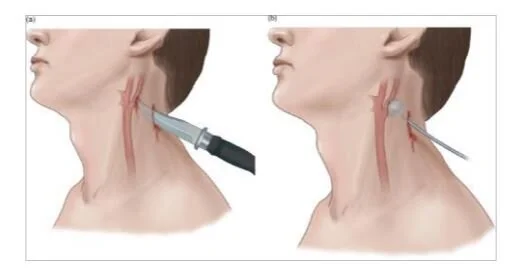Penetrating Neck Trauma
Airway
Have surgical airway set ready
Immediate Indications for intubation – severe distress, immediate airway compromise, exposed larynx or trachea, rapidly expanding hematoma (seconds to minutes)
Most patients you will have some time to make the decision to intubate
Most patients with hard signs should be intubated as they will be going to OR
A soft sign can be watched carefully, they might develop into hard signs
RSI VL, fiberoptic, or whichever method intubation the intubater is most comfortable with
Hard signs - airway compromise, expanding hematoma, active bleed, hemorrhagic shock, hematemesis, neurologic deficit, massive subcutaneous emphysema, air bubbling through wound
Soft signs - hemoptysis, oropharyngeal blood, dyspnea, dysphagia, dysphonia, nonexpanding hematoma, chest tube air leak, subcutaneous or mediastinal air, vascular bruit or thrill, crepitus
Hard signs - patient needs to go to OR
Soft signs – need CT angiography
C-collar in penetrating trauma
Probably not necessary, except altered mental status or neurologic deficits
C-collars can limit identification of the wound and application of pressure and airway management
If no clear deficits, spinal injuries, and AMS, can remove C-Collar to assess injury or intubate
GSW patients are at higher risk for spinal damage, so C-Collar is more important to the patient
Zones of the Neck
Really not very useful anymore as they don’t dictate management, used to be that Zone 2 injuries go to OR, not anymore
Zone 1 – clavicle and cricoid cartilage
Innominate vessels, common carotid artery, subclavian vessels, vertebral artery, brachial plexus, trachea, esophagus, apex of lung, thoracic duct
Zone 2 – between cricoid cartilage and angle of mandible
Contain carotid and vertebral arteries, internal jugular veins, trachea, esophagus
Zone 3 – area between angel of the mandible and base of the skull
Contains the distal carotid and vertebral arteries and pharynx
Pulsatile Bleed
Apply pressure, gloved direct pressure is sometimes better than gauze as you might not be compressing the right location with gauze, can consider placing a foley balloon into base of bleed and inflate
IV access, O2, airway, blood products
In community, stabilize and transfer

